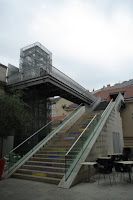 Beşinci günümüz oldukça yoğundu. Tur firmasının düzenlediği gezi ile önce, ilginç mimarisiyle gezmeye doyamadığımız küçük kaplıca-spa kenti Baden'e, sonra Habsburg Hanedanı'nın sonunu getiren facianın gerçekleştiği Mayerling'e, sonra da yeraltı sularının baskını sonucu Avrupa'nın en büyük yeraltı gölü haline gelen ve aslında bir kireç madeni olan Seegretto'ya gittik.
Beşinci günümüz oldukça yoğundu. Tur firmasının düzenlediği gezi ile önce, ilginç mimarisiyle gezmeye doyamadığımız küçük kaplıca-spa kenti Baden'e, sonra Habsburg Hanedanı'nın sonunu getiren facianın gerçekleştiği Mayerling'e, sonra da yeraltı sularının baskını sonucu Avrupa'nın en büyük yeraltı gölü haline gelen ve aslında bir kireç madeni olan Seegretto'ya gittik.


Grup'la tekrar buluşup Hundertwasser'in ünlü apartman bloğunu ziyaret ettikten sonra 165m yükseklikteki Viyana Kulesi'ne (Donautrum) çıkıp kahve-pasta eşliğinde 360° Viyana manzarası izledik.


Our fifth day was quite busy. First we attended a tour to a small spa town with interesting architecture, Baden. Then we moved on to the place where the Mayerling Incident took place. That incident brought the end of the Habsburg Dynasty. We continued with Seegrotte, which was once a lime mine, but flooded by underground water because of misplaced explosives and became the largest underground lake of Europe.

Back in Vienna we visited the enormous Karl Marx Hoff, almost first example of mass housing and then went to Museumsquartier and visited the National Museum.

Rejoining the group, we went to the well-known apartment block of Hundertwasser and then to the 165m high Vienna Tower (Donautrum) and enjoyed the 360° panorama of Vienna while having our cake and coffee.













































1 yorum:
Bayıldım.Ellerine,emeğine,yüreğine sağlık.
Yorum Gönder